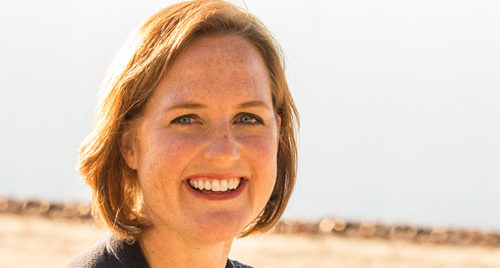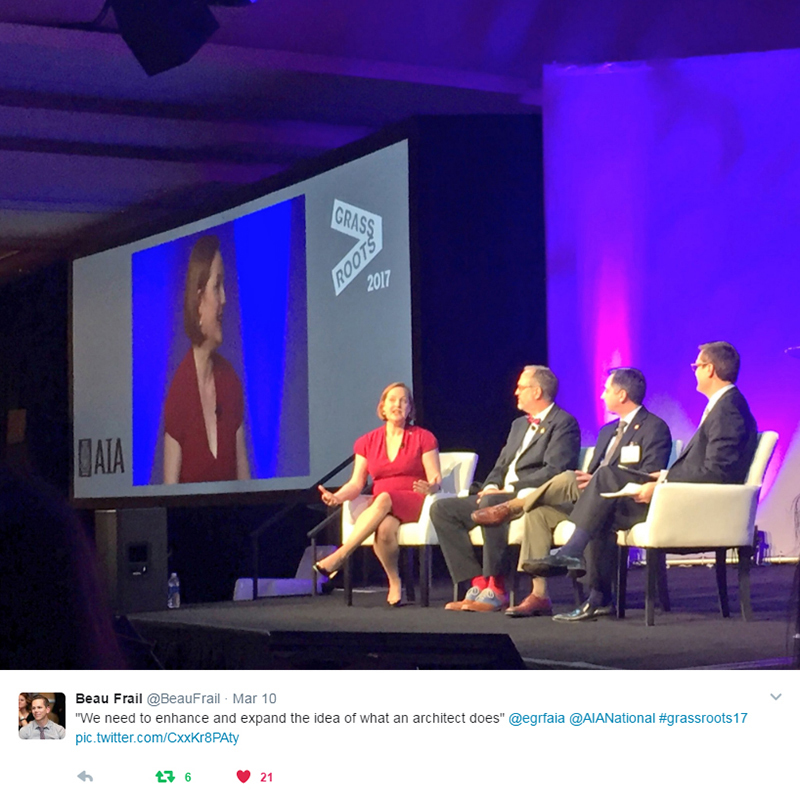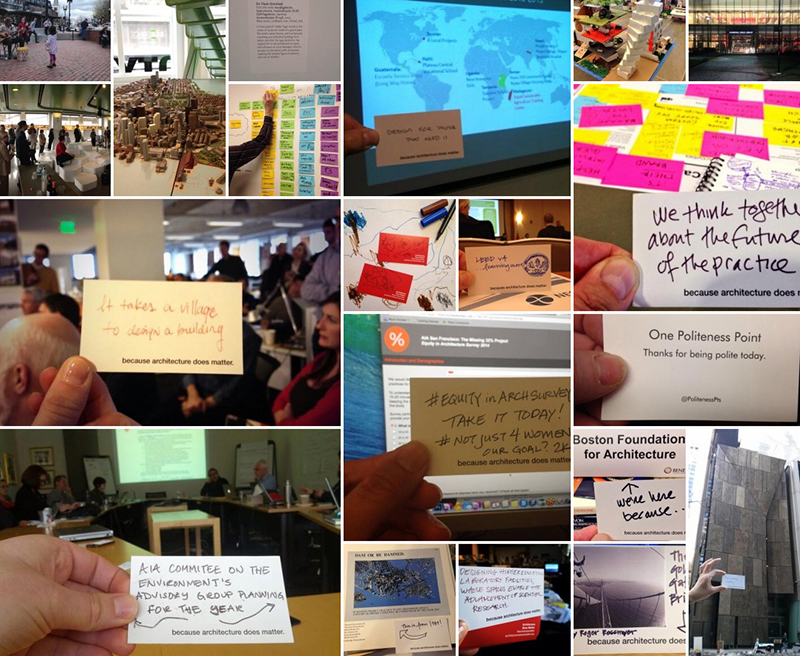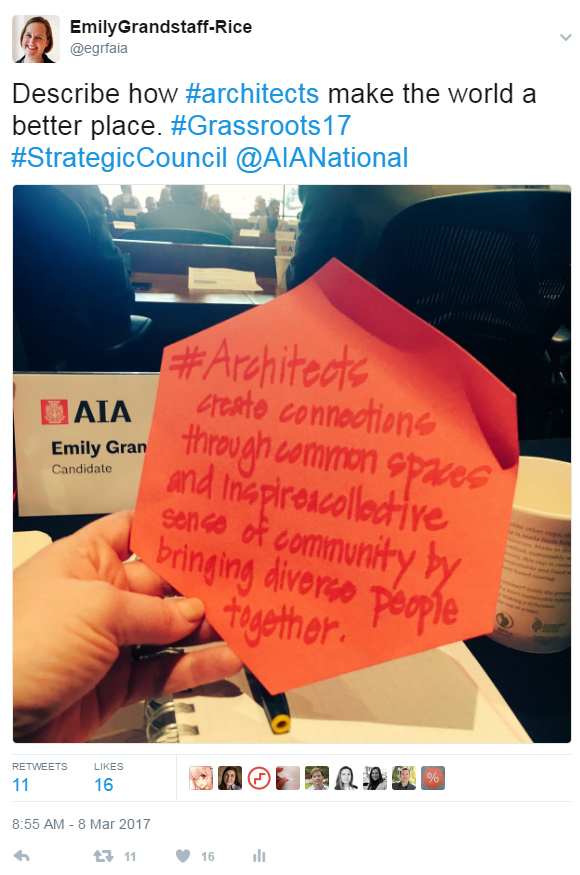Emily Grandstaff-Rice FAIA

Job title and company: senior associate, Arrowstreet
Degrees: Master of Liberal Arts, Educational Technologies, Harvard University; Bachelor of Architecture, Rensselaer Polytechnic Institute; Bachelor of Science, Building Sciences, Rensselaer Polytechnic Institute
Professional interests: Continuing education, emerging professionals, sustainability, K-12 outreach, promoting architecture through educational technology
Emily Grandstaff-Rice FAIA was elected the 2018–2020 At-large Director position on the AIA Board of Directors. She recently chaired the AIA National Equity in Architecture Commission that provided recommendations for expanding and strengthening the AIA’s commitment to equity, diversity, and inclusion in the profession of architecture. As the 2014 President of the BSA she was instrumental in advancing the work of the BSA and the profession through public initiatives, focus on the future business practices of architecture, and impact on the communities where we live.
What are you working on now?
At Arrowstreet I am involved in two K-12 projects: the Brooke Charter High School in Mattapan that will be under construction soon, and the Hildreth Elementary School in Harvard, Massachusetts. Additionally I have been working within the office on initiatives that support the firm’s vision and mission of the future of practice.
Ongoing work with the BSA includes contributing to the Equity Roundtable—a group of architecture professionals interested in making conversations about diversity and equity engaging and accessible. At the AIA national level, I am co-chair of the Equity and Future of Architecture Committee with Rosa Sheng AIA. This committee is directly responsible for implementing the Equity in Architecture recommendations and representing the AIA with issues of diversity and inclusion.

Image courtesy of Beau Frail.
How do you explain to your non-architect friends what you do for a living?
I creatively solve problems. I have always been fascinated by the process of being able to take a client’s needs, aspirations, and vision and being able to translate that to a physical environment. That will never get old for me.
What are some of your favorite examples of architecture?
I am in awe of the recently opened National Museum African American and Culture on the National Mall by Freelon Adjaye Bond/SmithGroup with exhibits by Ralph Appelbaum Associates. Phil Freelon FAIA and Zena Howard AIA spoke in Boston a couple of months ago about their professional and personal journeys through realizing that project from concept to completion. It is a testament to crafting an experience, an object, and a building that speaks and defines part of our American culture and heritage.
Who and what do you draw inspiration from?
Clients, colleagues, and community.
One of the great things about working with unique clients is that I learn as much from them as they do from me. When you develop a truly collaborative relationship, the process requires as much listening as designing. I have been and always will be inspired by my colleagues at Arrowstreet and in the architectural profession at large whom I have met through the BSA and AIA. For me, architecture is a collaborative, cultural practice—when you surround yourself with inspiring people, the work just gets better. Lastly, my local community in Boston and Somerville—it has been amazing to see the newfound advocacy and conversation about social justice.

Image courtesy of Emily Grandstaff-Rice.
If you could give the you-of-10-years-ago advice, what would it be?
The last time the BSA asked me this, my answer was to not take things too seriously. Today, my advice would be to understand the business of architecture and the value proposition of our work. Maybe that’s the realist in me or that I am now on the other side of the great recession. The architecture profession has changed a lot in the last ten years; I no longer see change as something to be fearful of.
What are you reading now?
I am reading two things right now: The New Better Off: Reinventing the American Dreamby Courtney E. Martin, a thoughtful book exploring contemporary ideas of what it means to be successful, part of a community, and making creative choices in life; and Monstrous by local author MarcyKate Connolly, a young adult book that is part Frankenstein and part Brothers Grimm that my 10-year-old just devoured. Reading the same books as my kids gives us something to talk about.
What do you hope to contribute from your work?
Having served on the BSA Board of Directors from 2009 to 2015, I learned firsthand the importance of advocacy in our community and for the profession. The BSA does many things: it serves as a trade association to stimulate the demand for architecture in Boston, a learning community for design professionals, an advocate for the built environment, and a public center for architecture to increase the dialogue and thought about how architecture impacts how we work, live, and play. My BSA involvement has influenced my day-to-day work professionally and with the AIA. I work to create amazing spaces that inspire and improve people’s lives.

Image courtesy of Emily Grandstaff-Rice.
How does this shape your decision to run for the AIA National Board?
I am very proud of the work that the BSA continues to accomplish in Boston—a complex, urban, historic city. I believe my experience with the BSA and AIA initiatives would provide the AIA Board a unique perspective. The world’s population is becoming increasingly urban. The UN projects that 66 percent of the world’s population will live in cities by 2050. That’s not that far off when you consider 2050 is only 33 years away. (Yikes, and given my age I just realized I may still be in architectural practice then.) It’s not just about building in cities, but also resiliency, historic preservation, social justice, community building. I am encouraged by the recent AIA statement of our values where the AIA National Board identified the following:
- We stand for equity and human rights
- We stand for architecture that strengthens our communities
- We stand for a sustainable future
- We stand for protecting communities from the impact of climate change
- We stand for economic opportunity
- We stand for investing in the future
- We speak up, and policymakers listen
I feel strongly that I have the voice, creativity, and leadership to help shaping these values to create meaningful change in the AIA and in our communities.
What do you believe are the important issues facing the AIA and the Board?
The AIA faces challenges in ensuring all members of our diverse, thoughtful community are engaged and involved. Local AIA components are integral to any future solution; they have a front row seat to the innovative and creative solutions in their communities. Local AIA components serve as the connection between local issues and the core values held at the national level. There are three elements of building increased member engagement: leveraging the face-to-face, positive work of AIA components; developing effective communications; and strengthening the value proposition of being an engaged AIA member.
I believe that the Board has really come into its own this year taking clear, strong advocacy positions. Architects have a unique knowledge and expertise with issues involving buildings and built environment. It is our responsibility to share this perspective. If the AIA doesn’t advocate for its members and the profession on issues that align with its values and public policies, who will?
Tell us what you bring to the AIA Board?
Humor. Experience. Creativity.
I am the only candidate who has held leadership positions in the AIA (Continuing Education Committee Chair, Culture Collective Member, Chair of Equity in Architecture Commission, Knowledge Scholar, Young Architects Forum) without having served previously on the AIA Board or Strategic Council. I see this as an asset—there has to be multiple paths to serve the AIA nationally if we hope to engage and attract future, diverse leadership.
If you could sum up your outlook on architecture in a bumper sticker, what would it say?
As BSA President in 2014, I launched a personal project titled Architecture Does Matter to start a dialogue about the importance of architecture and highlight the work and passions of architects. I passed out business cards and encouraged people to share their personal experiences on how architecture creates meaning. This experiment continues to ground me, and I love that I will get new additions from time to time.

